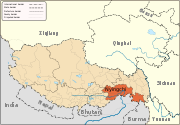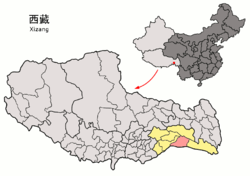- Mêdog County
-
Mêdog County
Pemako, Pemakod— County — Tibetan transcription(s) – Tibetan – Wylie transliteration – pronunciation in IPA – official transcription (PRC) – THDL – other transcriptions Chinese transcription(s) – Traditional – Simplified – Pinyin Location of Mêdog County within Tibet Location in Tibet Coordinates: 29°29′N 95°30′E / 29.483°N 95.5°E Country China Province Tibet Prefecture Nyingchi Prefecture Capital [[]] Time zone China Standard (UTC+8) Mêdog County, (Tibetan: པདྨ་བཀོད་ Wylie me tog rdzong; Chinese: 墨脱县; Pinyin: Mòtuō Xiàn) is a county of the Nyingtri Prefecture in the Tibet Autonomous Region of People's Republic of China. Chinese claims include parts of Arunachal Pradesh, south of the McMahon Line, what was casus belli for the 1962 Sino-Indian War.
Contents
Geography
Medog County or Metok is located in the southeast of the Tibet Autonomous Region and at the lower branch of Yarlung Zangbo River. Medog County covers an area of 30,553 square kilometres. The average altitude of the county is 1200 metres above sea level.་Metok county is also called Pemakö. The route for hiking to Medog: Paizhen(派镇)-Songlinkou(松林口)-Lage(拉格)-Hanmi(汗密)-Aniqiao(阿尼桥)-Beibengxiang(背崩)-Modog(墨脱)
Highway
In December, 2010 the Chinese government announced completion of a highway to Mêdog County, the last county in China which did not have road access.[1]
Economy and wildlife
Farming is the main industry in Medog County. It is abundant with paddy, soybean, cotton and gingeli, etc. Hairy deerhorn, gastrodia tuber, muskiness, and hedgehog hydnum, etc. are special products of the area.
The Medog National Animal and Plant Reserve Area is in the county. It has more than 3,000 species of plants, 42 species of rare wild animals that under special State protection, and over a thousand of hexapod species.
Demography
Medog county has a population of 9,200, and most people who live in the county are of Tshangla ethnic minority and Lhoba ethnic group. The most renowned part of Medog is known as Pemakö, one of Tibet's most sacred power places. Inhabitants of Pemakö call themselves pemaköpa and speak Tsangla language, closely related to that of sharchokpa of eastern Bhutan.They practice Nyingma tradition of Tibetan buddhism. Frank Kingdon-Ward was the first Westerner to penetrate the deepest gorges of Pemakö, chronicled in his 1925 tome Riddle of the Tsangpo Gorges. In his 1994 "Tibet Handbook" Hongkong-born Victor Chan describes the extremely difficult trek from Pemakö Chung to the power-place and beyul of Gonpo Ne, one of the most remote spots on earth. A modern journey by Ian Baker and his National Geographic-sponsored team to Pemakö received book-length treatment his 1994 book The Heart of the World.
Tribe
(门巴族) the Chinese minority one. There are currently 50000 people, in our controlled areas only 7475 people, and the rest living in Indian-controlled area. Mainly live in Tibet Medog County and the county wrong, Nyingchi, Chayu also the distribution of counties. Mainly engaged in agriculture. Specializes in the preparation and production of bamboo wood-Wan. Have their own language. mainly located in the southeastern part of the minority of the Tibet Autonomous Region of China, mainly live in the county south of the wrong door corner areas, the rest living in Medog, Nyingchi counties. Population of 5 million people, of whom are located in controlled areas within the reality of our country only 7475 people living in the wrong the rest of the county district in southern Kashmir. "Mamba", was originally a Tibetan name for them, which means living in the corner of one door. After new China was founded, in accordance with the wishes of the nation, officially named (门巴).
See also
- Pemako
Notes
- ^ Edward Wong (December 16, 2010). "Isolated County in Tibet Is Linked to Highway System". The New York Times. https://www.nytimes.com/2010/12/17/world/asia/17tibet.html. Retrieved December 17, 2010.
Nyingchi Prefecture, Tibet County-level divisions 
Geography Ba River · Nyang River · Pagsum Lake · Mount Nyainqentanglha
Towns and villages Categories:- Counties of Tibet
- Nyingchi Prefecture
- Nyingchi Prefecture geography stubs
Wikimedia Foundation. 2010.



